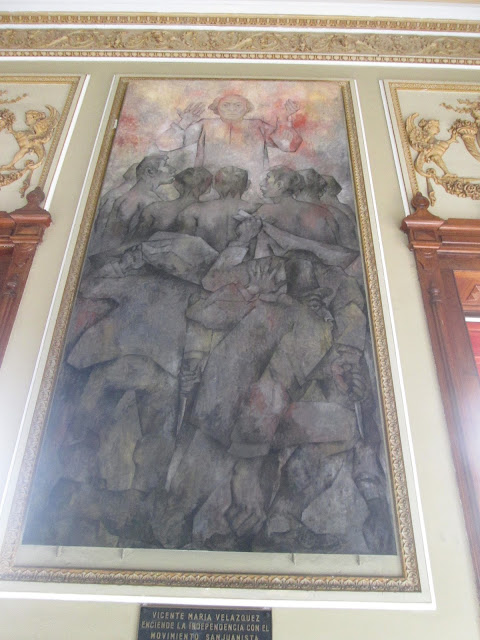Not one to let a good day go to waste (since I had taken the bus into the city and my return ticket was good until evening), after a fabulous late breakfast at a tiny café in the Catherwood House (itself worthy of a post sometime), I let my feet lead me back to the Plaza Grande in the center of Merida, and eventually into the Palacio de Gobierno and its famous murals.
The spouse and I had spent time last year with these paintings depicting the area's long human history, but since mi memoria es malo, I opted for a little educational reinforcement (seldom a bad idea). Like anyplace inhabited by humans for multiple thousands of years, the Yucatan Peninsula has seen its share of tragedy. The Maya, whose ruined buildings are found every few miles across the peninsula, warred with their neighbors and each other until being conquered by the Spanish in the 1500s. The Spaniards, who seem to have behaved badly all over the world, fought numerous wars with the indigenous peoples over a few hundred years. In post-independence 1847, the basically-enslaved, mostly Maya workers on the wealthy sisal plantations of the Yucatan began the Caste War, a guerrilla insurgency that lasted until 1901 and resulted in something like 300,000 deaths. Following the early 20th-century Mexican War, progressive governors began changes--but more wars and, sometimes, executions and assassinations put an end to those reforms.
Still, some people did (some) good things.
- Gonzalo Guerrero married a Maya princess and became the "father of los mestizos."
- Father Diego de Landa, bishop of Yucatan until his death in 1579, destroyed Mayan codices (and to be fair to him, may actually have thought that he was trying to eliminate human sacrifice)--but then wrote the book that contains much of what we know about Maya culture and religion.
- Vicente Maria Velazquez, a Fransciscan priest, agitated for Mayan rights in the early 19th century (unlike some of his predecessors, seeing no conflict between his religion and the physical well-being of his parishioners). Unfortunately, the Palacio has no ladders from which one might get a better photo of this large painting that reaches almost to the (very high) ceiling.
- Salvador Alvarado, revolutionary and governor of the Yucatan from 1915-18. In 1916, he sponsored the first Feminist Congress in Mexico, while passing laws on workers rights, public education, and divorce. He is sometimes called "the one true liberator of the Mayan slaves."
Not a bad way to spend part of an afternoon.




No comments:
Post a Comment